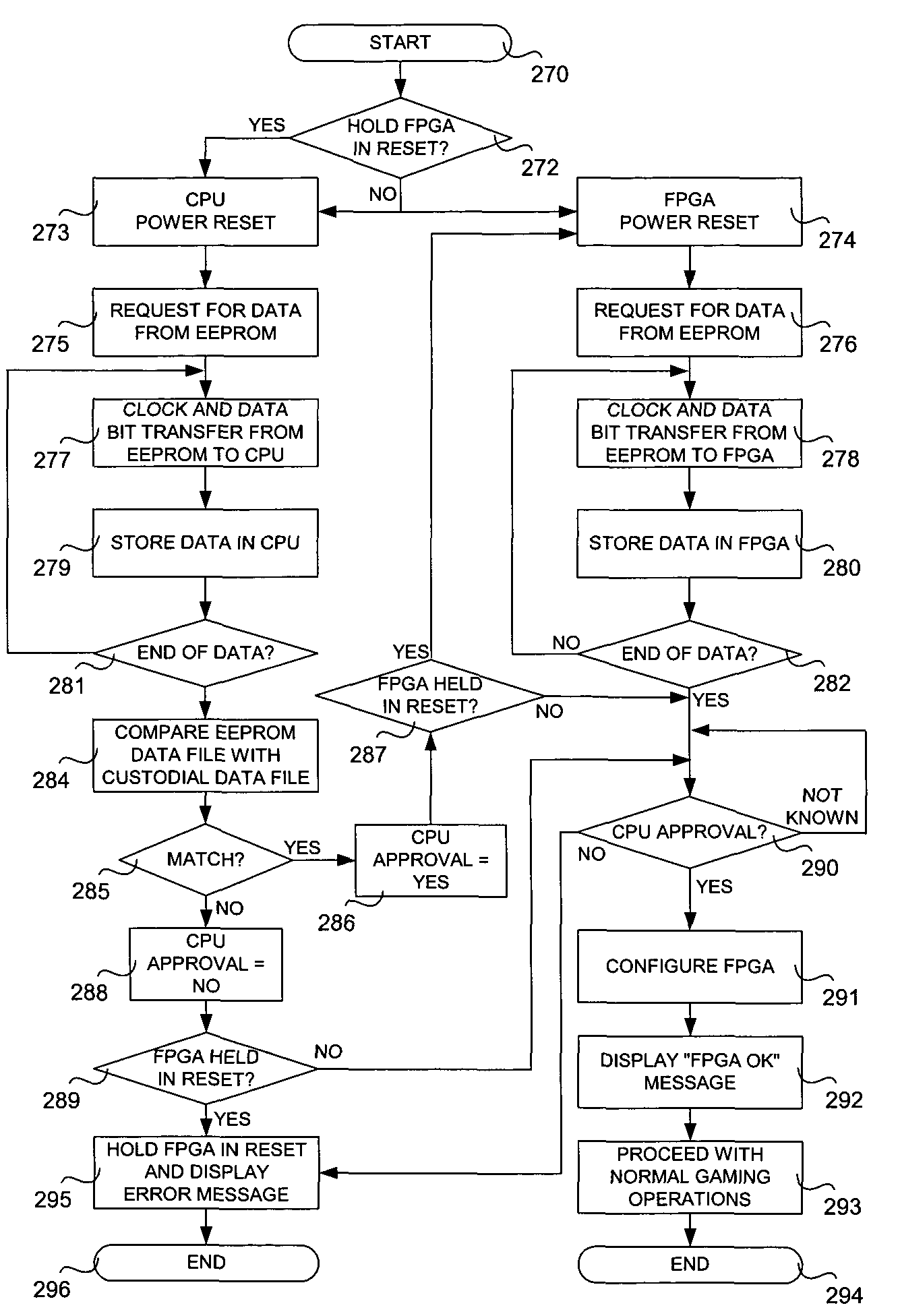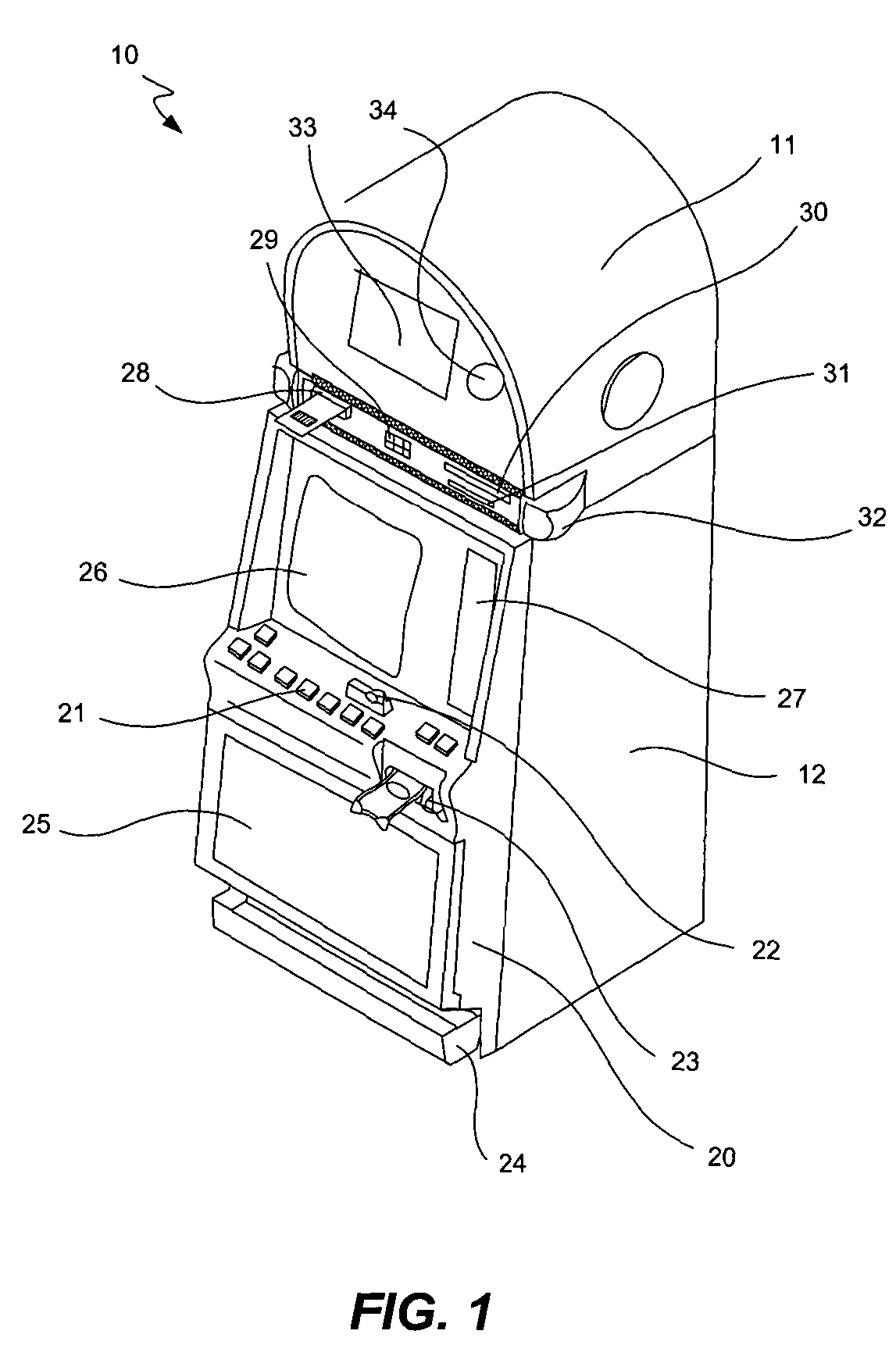Because casinos and other forms of gaming comprise a growing multi-billion dollar industry wherein large sums of money can quickly change hands during many types of fast paced games, casinos and other gaming establishments are a prime target for thieves, cheats and a variety of assorted
cons.
Gaming machines, and
microprocessor based gaming machines in particular, comprise a particularly favorite target for such activities, due in part to their relatively isolated nature and increasing technological complexity and sophistication.
One such way to cheat or defraud a gaming machine is to introduce unauthorized or otherwise unsecured data or
machine code into the gaming machine in a manner so as to trick or defeat the
programming or
electronics of the machine, and such techniques have been the modus operandi of many hackers and cheats.
Unfortunately, however, such simple printed circuit boards could be easily modified to change the connections of these elements surreptitiously.
As is generally known in the art, such SPLDs and CPLDs are essentially chips that comprise a plurality of
internal logic gates with internal programmable interconnections, such that
cutting and
jumping techniques are rendered significantly more difficult, or even impossible.
Additional security features also usually exist in this type of hardware, such as one or more protection features that keep the information inside the device from being read, which feature or features makes it difficult to reverse engineer such devices or parts.
Because
cutting and
jumping techniques are not the only ways whereby a gaming machine (or other electronic device) can be electronically defrauded, gaming industry regulations and laws have also historically forbidden the use of “writable” memory devices for the storage of computer codes that control various significant aspects associated with a gaming machine, such as payouts.
It is readily apparent that such computer codes are critical, in that any manipulation or corruption of such codes or files, either accidentally or deliberately, can result in the defrauding of the gaming machine or the
cheating or shortchanging of players.
Because of such regulations, and because code or file manipulation or corruption poses such a significant
threat to the integrity of a gaming machine, storage of most or all gaming machine codes is typically handled by less volatile (i.e., non-writable) types of memory, such as those found in standard
Read Only Memory (ROM) or some types of Electrical Erasable
Programmable Read Only Memory (
EEPROM) devices.
In recent years, technological advances and the demands for more sophisticated gaming machines have resulted in devices of even greater complexity being designed into gaming machines in place of the relatively smaller SPLD, CPLD and other similar devices.
An FPGA, or a similarly large volatile programmable electronic device, is generally a substantially larger and more complicated device that can
handle not only many or all of the various interconnections and codes required for all of the various machine elements, but is also large enough to function as many or all of the actual decoders,
bus steering, addressing, decoding, logic blocks and the like required within the gaming machine as well.
One problem associated with a large and comprehensive volatile programmable device such as an FPGA, however, is that such devices contain a sufficient amount of
internal memory and data that can be used to hack other programs or provide a hack code itself.
Unlike the obvious instances of
cutting and
jumping, however, if the configuration information or data read into an FPGA or similar device has a hacked code,
algorithm or data in it, inspectors and regulators may never be able to detect that hacking has occurred.
This is especially troublesome where third parties have access to a configurator, such as an
EEPROM, ROM or other configuring memory component, before or during installation into the gaming machine, or where third parties who are familiar with the type of configuring memory components in a gaming machine are able to attempt a “
cut and jump” from an intended configuring memory component to a similar but differently programmed hack memory component.
Such a procedure can tend to be time-consuming and stressful, however, as authorities need to be called in, the affected gaming machine must be taken apart, the appropriate
chip or chips must removed, the appropriate custodial authenticating version or versions must be found, and all chips must then be placed on a special testing board and tested for authenticity.
In addition, items such as FPGAs, ROMs, EEPROMs and the like are static sensitive devices that can be damaged or have internal data corrupted if not handled properly, rendering the physical removal of such components for testing and / or
reprogramming purposes a less than ideal circumstance.
Furthermore, continued removal and replacement of such items introduces
wear and tear to various contacting components, whereby parts are eventually worn out even where one or more individual pins or contacts are not significantly damaged in certain cases of removal and reinsertion.
 Login to View More
Login to View More  Login to View More
Login to View More 


